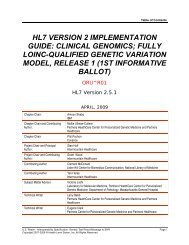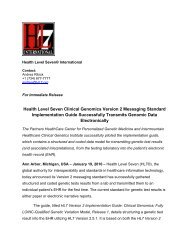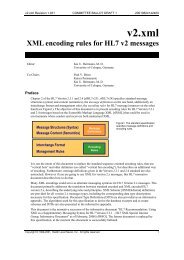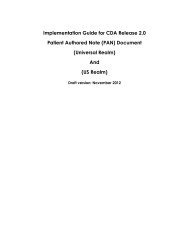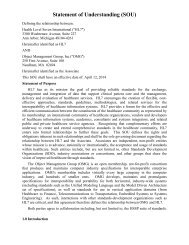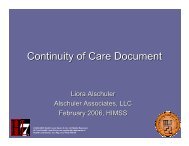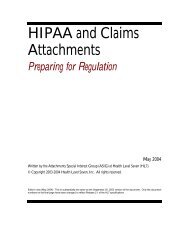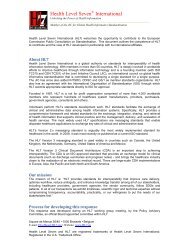HL7 CDA R2 AIS Implementation Guide
HL7 CDA R2 AIS Implementation Guide
HL7 CDA R2 AIS Implementation Guide
You also want an ePaper? Increase the reach of your titles
YUMPU automatically turns print PDFs into web optimized ePapers that Google loves.
<strong>HL7</strong> Additional Information Specification <strong>Implementation</strong> <strong>Guide</strong><strong>CDA</strong><strong>R2</strong><strong>AIS</strong>0000R0303 <strong>CDA</strong> Attachment Compliance Statement (Normative)This chapter provides the normative information that describes how compliance with theattachments implementation guide and the <strong>AIS</strong> documents is determined. It provides a series ofcompliance statements (rules) that can be used to determine that a specific attachment complieswith this implementation guide and the relevant Additional Information Specification.The compliance statements are normative components of this guide. This means that they makeup the authoritative content (that which must be followed to be in compliance).Non-normative examples may be provided to illustrate compliance, but judgments about thecompliance of an implementation cannot be made from the examples. The examples do not showevery legal variation that could be present. Examples in this section are not normative. Theyrepresent specific instances that meet the compliance statement that they accompany. An examplein this section is typically not a complete attachment document. It is a fragment that illustrates thecompliance statement it accompanies.3.1 DefinitionsThe following definitions apply to terms as used in the compliance statements for this document.Some of these terms and definitions, such as ‘may’, ‘shall’, ‘need not’ and ‘should’ are consistentwith the <strong>HL7</strong> standards as defined in the <strong>HL7</strong> publishing guide.Attachment Component. A portion of an attachment that represents one or more attachmentcomponent answer parts as defined in section 2.9.Attachment Component Answer Part. A portion of an attachment that represents a single unitof information identified by a LOINC code as defined in section 2.9.Attachment Document. The <strong>CDA</strong> document that is part of an Attachment Package.Attachment Package. The combination of a <strong>CDA</strong> document and any adjunct files (e.g., images)that are transmitted together in fulfillment of an administrative transaction (e.g., included in theBIN segment of an ASC X12 275 transaction as transmitted from a provider to a payer). ForHIPAA, the Attachment Package defines the full requirements of the required administrativetransaction.<strong>CDA</strong> Content. <strong>CDA</strong> content appears as P<strong>CDA</strong>TA within structural elements.<strong>CDA</strong> Structure Element. One of the XML elements used to structure text within a <strong>CDA</strong>document. These elements appear beneath the element of the within a <strong>CDA</strong>document, and include such elements as , or .Computer-decision variant. An instance of a <strong>CDA</strong> attachment with enough structure and codingso that it can be rendered with detailed data suitable for a computer decision algorithm.Attachments in the computer-decision variant can also be rendered so that a person can make adecision based on its contents. Contrast with human-decision variant.Deprecate. Used to describe a feature that is permitted but not recommended. It is the equivalentof "should not." Features that are deprecated may be forbidden in future releases of the standard.Human-decision variant. An instance of a <strong>CDA</strong> attachment intended solely for rendering so thatPage 38March 2007Copyright © 1998-2007Health Level Seven, Inc. All rights reserved.Release 3.0 Draft Standard




